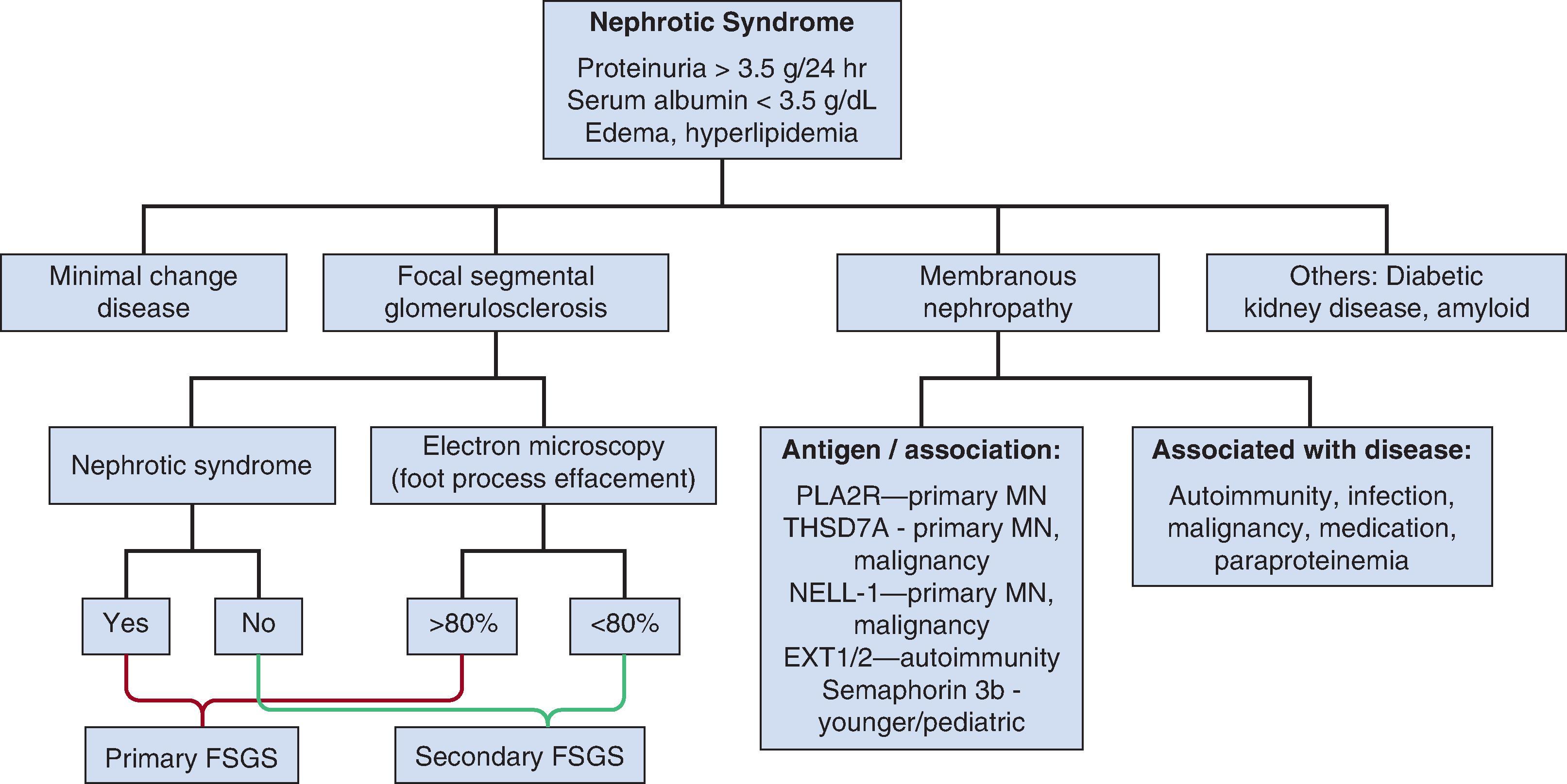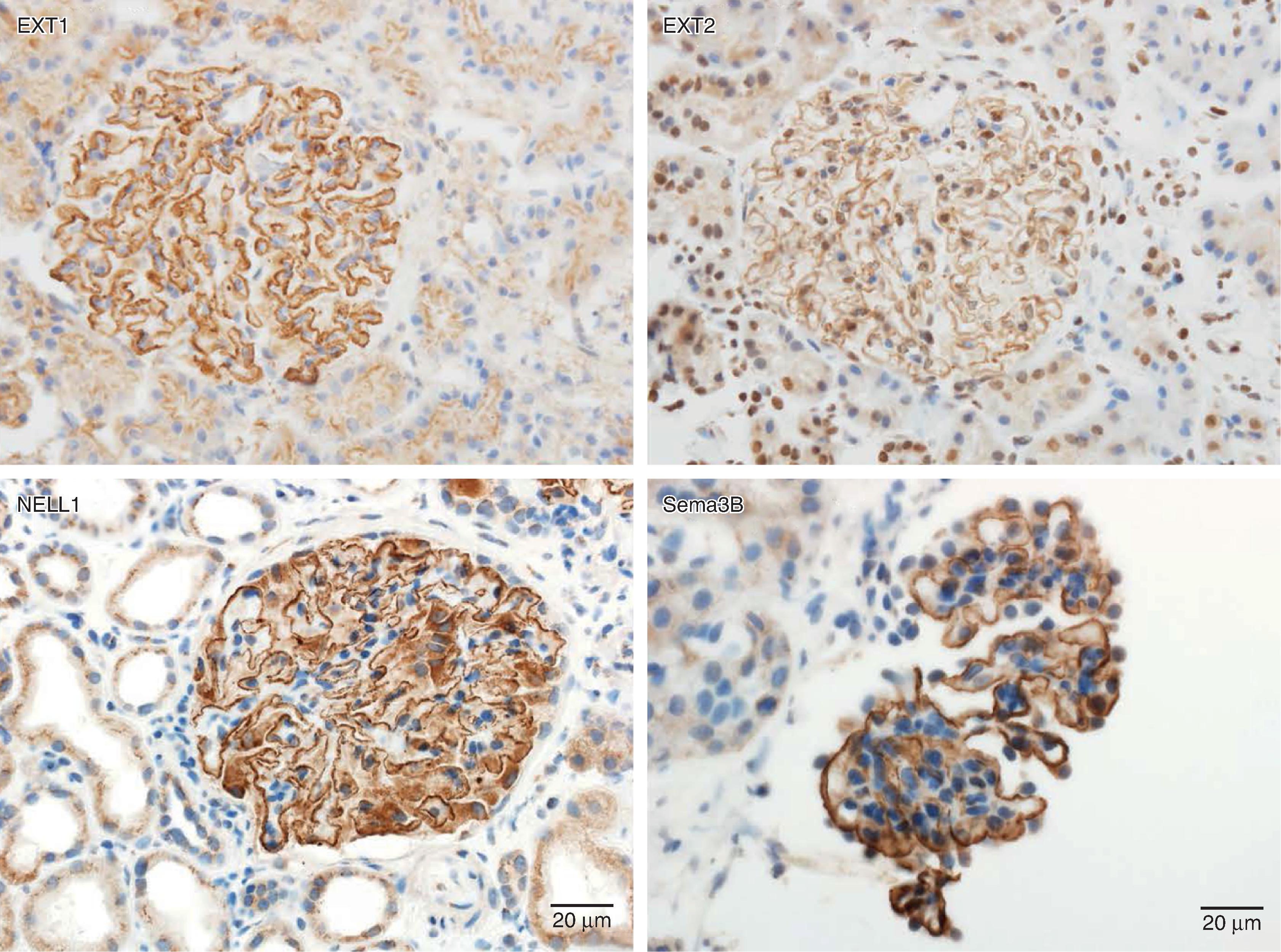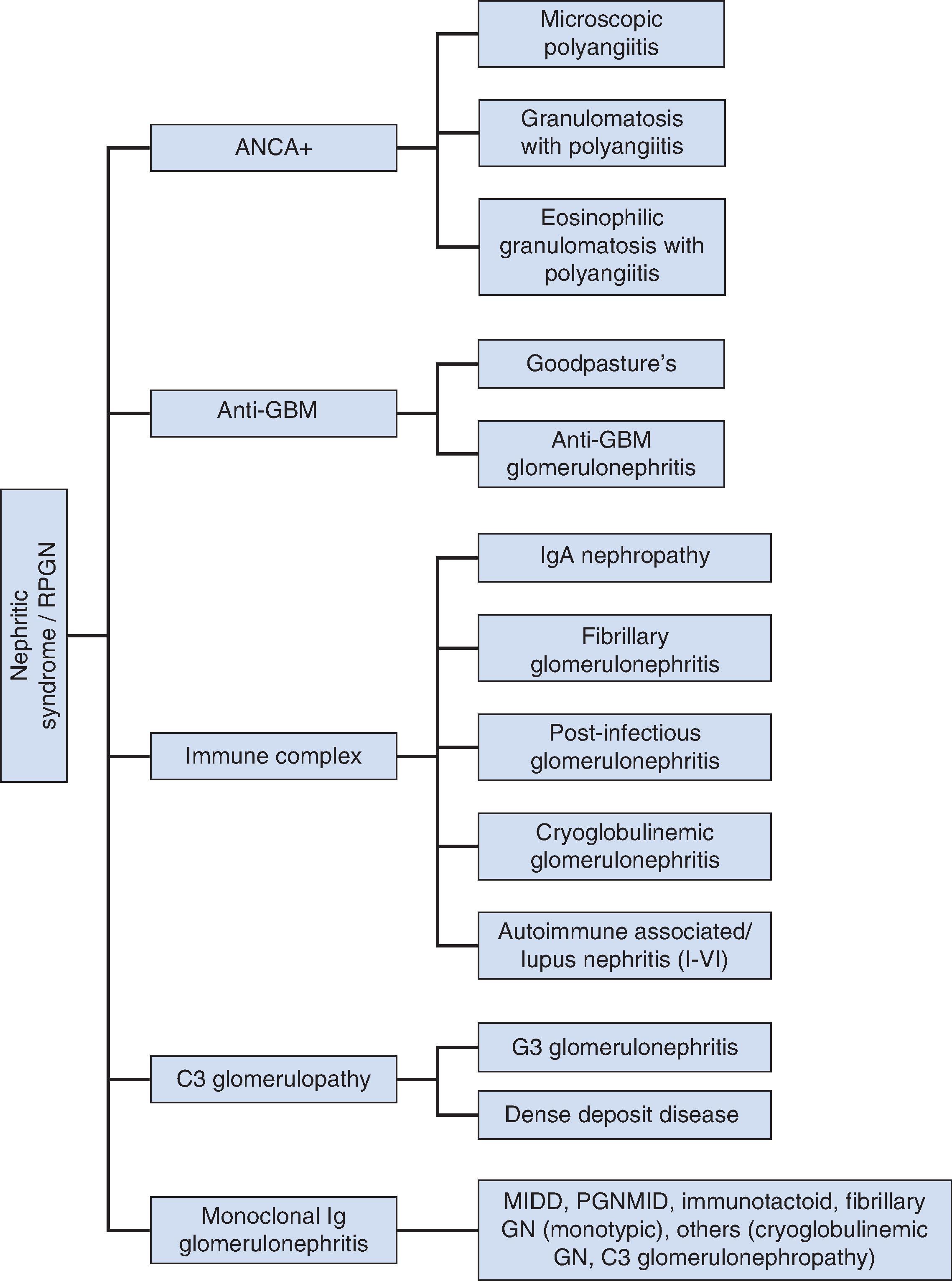Physical Address
304 North Cardinal St.
Dorchester Center, MA 02124
Glomerular disease is the third most common cause of end-stage kidney disease worldwide. Glomerulonephritis (GN) has diverse presentations and work-up requires serum chemistry, serology, urinalysis with microscopy, and quantification of proteinuria. Patients present with several clinicopathological syndromes that can have various etiologies. These syndromes share similar characteristics in terms of findings on urinalysis, degree of proteinuria, presence of reduced glomerular filtration rate, edema, and hypertension, among others. Kidney pathology identifies several patterns of injury that can overlap among the causes of GN and, as a result, an etiological-based classification of these disorders is preferred. In this chapter, we will describe nephrotic syndrome, nephritic syndrome, rapidly progressive glomerulonephritis, and pulmonary-renal syndrome and highlight glomerular diseases associated with systemic disorders such as lupus nephritis, monoclonal immunoglobulin associated glomerulonephritis, and thrombotic microangiopathies.
Nephrotic syndrome is defined as more than 3.5 g of proteinuria in 24 hours, with serum albumin level less than 3.5 g/dL accompanied by hyperlipidemia and clinically apparent edema. The most common glomerular diseases manifesting as nephrotic syndrome (NS) are minimal change disease (MCD), focal segmental glomerulosclerosis (FSGS pattern of injury), and membranous nephropathy (MN). These lesions share the clinical characteristic of nephrotic-range proteinuria and the pathological finding of extensive podocyte foot process effacement on electron microscopy. Systemic causes of NS include diabetic kidney disease (DKD) and amyloidosis ( Fig. 16.1 ), among others. Demographic characteristics, clinical history, and laboratory and serological findings, in addition to kidney pathology, aid in obtaining an accurate diagnosis, etiology, and management.

The most common clinical characteristics include edema, lipiduria, and hyperlipidemia but are not necessary for diagnosis. Complications may arise due to urinary protein loss, including iron deficiency anemia due to the loss of transferrin, vitamin D deficiency due to loss of vitamin D-binding protein, and hypogammaglobulinemia predisposing to sepsis and concurrent acute kidney injury (AKI). An important clinical complication to recognize is hypercoagulability, which occurs due to the urinary loss of protein C, protein S, plasminogen, and anti-thrombin III. Renal vein thrombosis can occur when there is severe proteinuria (>10 g/24 hr) and severe hypoalbuminemia (<2 g/dL). Hypercoagulability is more common in NS due to membranous nephropathy and amyloidosis. Due to low oncotic pressure, low effective circulating volume can also be present resulting in AKI.
The goals of management in nephrotic syndrome should be focused on addressing complications and a comprehensive antiproteinuric strategy. A low-salt, protein-restricted diet (0.8 to 1 g/kg/day), in conjunction with ACE inhibitor or ARB therapy, is a cornerstone of non-disease-specific management. Diuretics can be used to address edema, statin therapy for hyperlipidemia, and anticoagulation for those at high risk for thrombotic complications.
Minimal change disease (MCD) accounts for approximately 15% of adult nephrotic syndrome, increasing to over 70%-90% in the pediatric population. The pathogenic mechanism of MCD is unknown. However, there are well-known associations with NSAID use, thymoma and Hodgkin lymphoma, the last being suggestive of a T-cell-mediated mechanism.
In children, the presence of nephrotic syndrome without additional findings such as hematuria and reduced glomerular filtration rate (GFR) is considered MCD until proven otherwise and is often diagnosed and managed without a kidney biopsy. However, in adults, biopsy is important as there can be other diagnoses associated with this presentation. In support of its nomenclature, there are minimal/absent changes on light microscopy, but extensive foot process effacement on electron microscopy. The mainstay of therapy is corticosteroids; however, some forms may be considered steroid resistant. Additional therapies such as anti-CD20 monoclonal antibodies have been promising. MCD is discussed in detail in Chapter 18.
Focal segmental glomerulosclerosis (FSGS) is a histopathological lesion that commonly presents with nephrotic-range proteinuria as a result of podocyte injury and glomerular scarring. This clinicopathological syndrome is less common in children (<15%) but contributes as much as 25% of adult nephrotic syndrome and is the most common cause of idiopathic nephrotic syndrome among those of African descent. Compared to MCD, in addition to having glomerular scarring, patients with FSGS can also have concomitant hypertension, reduced GFR, and even microscopic hematuria.
FSGS is currently classified as primary, due to a yet-to-be-discovered circulating podocyte permeability factor, versus secondary, due to maladaptive, drug, and viral causes and genetic etiologies ( Table 16.1 ). As the name suggests, this histological lesion on light microscopy is focal, affecting only a portion of glomeruli, and segmental, involving a segment of the affected glomerulus. However, the lesion is not truly focal or segmental, as the name suggests, because on electron microscopy varying degrees of foot process effacement can be seen even in glomeruli that appear normal on light microscopy. There are five variants that are distinguished on light microscopy: cellular, tip, perihilar, collapsing, and not otherwise specified (NOS). The five variants do not help in distinguishing primary from secondary causes of FSGS. Of these, collapsing FSGS is strongly associated with viral etiologies such as HIV infection and typically presents with the abrupt onset of severe nephrotic syndrome with high-risk, progressive loss of kidney function.
| Primary FSGS |
| Attributed to a circulating podocyte permeability factor |
| Secondary FSGS |
| Viral: HIV-associated nephropathy, parvovirus B19, cytomegalovirus, COVID-19. Drug induced: heroin, interferon (α, β, γ), pamidronate, sirolimus, calcineurin inhibitors, anabolic steroids, direct-acting antiviral therapy (ledipasvir, sofosbuvir) Adaptive: reduced nephron mass or glomerular adaptation, low birth weight, partial nephrectomy, unilateral renal agenesis, obesity-related glomerulopathy, basement membrane defects healing phase of focal proliferative glomerulonephritis, body building, sickle cell anemia, hypertensive nephrosclerosis, thrombotic microangiopathy, aging kidney |
| Genetic FSGS |
| Genetic mutations in podocyte genes: NPHS1(nephrin), NPHS2(podocin), PLCE1(phospholipase C epsilon), INF2(inverted formin), ACTN4 (α-actinin-alpha 4), APOL1 |
Since there is no discriminatory laboratory test to differentiate primary from secondary FSGS, a thorough history, combined with serum and urine studies and kidney biopsy, can help classify the lesion. Primary FSGS will typically have an acute onset of nephrotic syndrome with low serum albumin and >3.5 g/day of proteinuria. Electron microscopy can demonstrate varying degrees of foot process effacement, with >80% generally considered diffuse and favoring primary FSGS versus <80% considered segmental and favoring secondary FSGS (see Fig. 16.1 ).
The clinical course is dependent on the response to immunosuppressive therapy such as corticosteroids, calcineurin inhibitors, and mycophenolate mofetil. Primary FSGS typically recurs shortly after kidney transplant, supporting its pathogenic circulating factor hypothesis. In contrast, secondary FSGS can gradually develop proteinuria of varying degrees and typically has a slowly progressive disease course. Management of secondary FSGS should be focused on the underlying etiology with a comprehensive antiproteinuric strategy and avoidance of unnecessary immunosuppression. This algorithm, however, does not apply to collapsing FSGS, given its easily distinguishable clinicopathological features and genetic causes with variable degrees of foot process effacement (see Fig. 16.1 ). Genetic causes can be suggested by a family history of nephrotic syndrome or other congenital findings, as well as a history of poor response to immunosuppression. The presence of APOL1 risk alleles, which is associated with increased risk of FSGS lesions and advanced kidney disease in patients of African descent, is an increasingly recognized form of genetic FSGS. From a prognostic perspective, patients with non-nephrotic-range proteinuria have the best outcomes; conversely, persistent hematuria or poor response to immunosuppression in primary FSGS is indicative of progression to end-stage kidney disease (ESKD). FSGS is discussed in detail in Chapter 19 .
Membranous nephropathy (MN) is the most common cause of adult nephrotic syndrome among whites and typically occurs in the fourth to fifth decade of life, with males and females affected in a 2:1 ratio. Among MCD, FSGS, and MN, the pathogenesis of MN is the best described since the discovery of several causative/associated antigens. Autoantibodies against the phospholipase A2 receptor are present in approximately 70% of primary MN, with another 1% to 3% of primary MN patients with autoantibodies to thrombospondin type 1 domain containing 7a (THSD7A). More recently, additional target antigens have been discovered including Neural epidermal growth factor-like 1 protein (NELL-1), Exostosin1/2 (EXT1/2), and Semaphorin 3B (Sema3b) . Further studies regarding the pathogenic ability and characterization of these antigens are required. However, several associations are already established. Secondary forms of MN are associated with autoimmunity (e.g., SLE), infections (e.g., hepatitis B), drugs (e.g., NSAIDs), malignancies (typically solid), and even paraproteinemias (see Fig. 16.1 ). EXT1/2 have been shown to be associated with MN in the setting of autoimmune diseases. As such, apart from recognizing the presence of nephrotic syndrome, a thorough evaluation includes assessing for the presence of autoantibodies and evaluation for potential associated causes.
Similar to MCD and FSGS, MN also has foot process effacement on electron microscopy, but the characteristic lesion of MN is the presence of subepithelial and intramembranous deposits in the glomerular basement membrane. On light microscopy, methenamine silver stain can show subepithelial spikes along capillary walls and immunofluorescence shows granular deposition of IgG and C3 along capillary walls. Biopsies can now also be stained for PLA2R, THSD7A, EXT1/2, NELL1, and Sema3B antigens ( Fig. 16.2 ).

Management of MN is determined by etiology and risk of progression. It is expected that one-third of patients will undergo spontaneous remission and another third, partial remission. Persistent nephrotic syndrome and or declining kidney function should prompt treatment with immunosuppression, especially in primary forms of MN. Calcineurin inhibitors, rituximab, or cyclophosphamide and steroids are treatment options when immunosuppression is warranted. Treatment of an underlying associated cause is key, if present. The ability of PLA2R antibodies to guide response to immunosuppressive therapy is well established. Patients with a progressive course should undergo evaluation for superimposed disease such as crescentic GN, or acute interstitial nephritis. MN is discussed in detail in Chapter 20 .
Diabetic kidney disease (DKD), discussed in more detail in Chapter 26 , is the most common cause of kidney failure in the United States, with diabetic kidney disease often initially manifesting 10 to 15 years after diagnosis of diabetes. The presence of diabetic retinopathy also correlates strongly with the presence of DKD. Risk factors for kidney disease in people with diabetes include obesity, hypertension, ethnicity, and the degree of glycemic control.
DKD occurs as hyperglycemia results in glycosylation end products that accumulate in the glomeruli. The result is the development of moderately elevated albuminuria (30 to <300 mg/24hr) in the early phase of disease, which then progresses to severely elevated albuminuria (≥300 mg/24hr). As with most glomerular disorders, the extent of proteinuria correlates with prognosis. As proteinuria progresses, kidney failure is the end result.
Kidney biopsy is not always performed, as individuals with long standing diabetes who present with albuminuria and no other evidence of concomitant disease are presumed to have DKD. However, abnormal serology, dysmorphic RBCs, or rapid kidney function decline should prompt kidney biopsy. Kidney biopsy findings in DKD include thickening of the GBM, glomerular hypertrophy, and arteriolar hyalinosis. The classic finding is mesangial expansion and Kimmelstiel-Wilson nodules.
The mainstay of treatment is with ACEi or ARB to reduce albuminuria, controlling hypertension, which is often co-existent, strict glucose control, and weight loss. More recently, sodium glucose co-transporter-2 (SGLT-2) inhibitors have shown great promise for DKD (see Chapter 26 ).
Nephritic syndrome is defined as the presence of glomerular hematuria in the form of dysmorphic red blood cells (RBCs) or RBC casts, in combination with hypertension, edema, reduced GFR with or without oliguria (depending on acuity), and non-nephrotic-range proteinuria. There are several forms of glomerulonephritis that can present with nephritic syndrome. They can be classified based on the etiology as immune complex-mediated, pauci-immune/ANCA-associated, anti-glomerular basement membrane (anti-GBM) antibody-mediated, or monoclonal gammopathy-associated, or linked to complement abnormalities (C3 glomerulonephritis) ( Fig. 16.3 ).

Rapidly progressive glomerulonephritis (RPGN) is a clinicopathologic syndrome that is defined by the rapid loss of kidney function over days to weeks in the context of nephritic syndrome. Many of the etiologies in immune complex-mediated, pauci-immune/ANCA-associated, and anti-GBM-mediated GN can present as an RPGN. In addition, several of the causes of RPGN can also present with concomitant pulmonary hemorrhage as a pulmonary renal syndrome, including ANCA-associated pauci-immune GN and anti-GBM glomerulonephritis (Goodpasture syndrome).
IgA nephropathy (IgAN) is the most common primary glomerulopathy worldwide. In the primary form, its pathogenesis is related to the deposition of immune complexes of anti-gliadin antibodies (IgG or IgA) and galactose deficient IgA1 in the mesangium of the glomerulus, resulting in an inflammatory cascade. This “primary form” is likely triggered by an inciting event such as an ongoing upper respiratory tract infection resulting in macroscopic (“synpharyngitic”) hematuria. Patients can also present with asymptomatic or microscopic hematuria detected on urinalysis, which may or may not be accompanied by proteinuria. The proteinuria in IgAN is usually in the non-nephrotic range; when present, nephrotic-range proteinuria should prompt the search for an underlying podocytopathy as well. IgAN can also present as a systemic vasculitis in the form of Henoch-Schönlein purpura (HSP) or IgA vasculitis, with classic skin, joint, and intestinal manifestations that seem to have a more favorable prognosis in children compared to adults. Secondary forms of IgAN occur in the setting of inflammatory bowel disease, advanced liver disease, ankylosing spondylitis, and dermatitis herpetiformis.
On light microscopy, typical findings are mesangial proliferation (M), endocapillary proliferation (E), segmental sclerosis (S), tubulointerstitial fibrosis (T), and crescents (C). These five findings comprise the MEST-C score and, while each lesion is not pathognomonic for IgAN, they guide prognosis at the time of biopsy. On immunofluorescence, mesangial IgA deposition is noted, which corresponds to mesangial electron dense deposits on electron microscopy.
As many as 60% of patients with IgAN can have a benign course; however, progression to kidney failure occurs in up to 40% of patients over 10-20 years from diagnosis. Allograft recurrence, although common, does not often result in allograft loss. There are three well-studied clinical predictors of progression, namely, renal insufficiency, hypertension, and >1 g/24 hr of proteinuria at biopsy diagnosis. Although the hallmark finding is hematuria, studies assessing its role in prognosis have produced mixed results. IgAN is unique from a pathology standpoint as the MEST-C score is a reliable method of prognostication with T score providing the most consistent guide for progression to ESKD across studies. IgAN is discussed in detail in Chapter 21 .
Become a Clinical Tree membership for Full access and enjoy Unlimited articles
If you are a member. Log in here